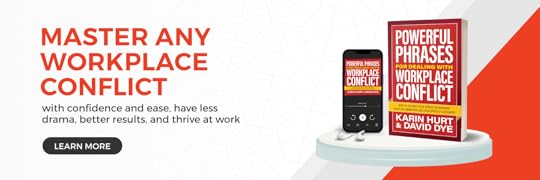David Dye's Blog, page 22
April 5, 2024
How Do I Encourage My Coworker to Take Initiative? (without coming across as a jerk)
Hi Karin, “I’ve got a peer who will never take initiative. I’m always stuck feeling like I’m the one to push if we’re going to get anything done. I really don’t like that feeling. What should I do? How can I get them to step it up? #AskingForaFriend.”
This one’s tricky. After all, they are your peer. You’re NOT the boss of them. And, it’s impacting you, your work, and your results. Work is more stressful than it needs to be. Let’s fix that.
Today’s “Asking for a Friend” features Glain Roberts-McCabe, PCC, CTDP (she/her) with expert advice for showing up curious and getting clear on your request.
What Does It Mean to Take Initiative?“Take initiative” is one of those phrases like “be more strategic” or “don’t be so negative” which can be a lightening for workplace conflict.
That request is just too vague for most people. If you want someone to take initiative, a good place to start is to be clear about what success looks like.
Taking initiative might mean anticipating potential problems and proposing solutions, seeking out opportunities for innovation or improvement, or voluntarily taking on additional responsibilities to relieve pressure on your team.
Defining what it looks like to take initiative in a specific context requires setting clear expectations about proactive behaviors, the scope of autonomy, and the desired outcomes. This clarity helps transform the abstract notion of “take initiative” into actionable, observable actions, which enables the person to to contribute more effectively.
How to Start the Conversation

Understand that we all have different motivational energies. Some of us like to move fast. Some of us like a little slower, steady pace. And really it’s often that energy gap that’s causing all kinds of tension.
When you start there, it’s easier to give that co-worker the benefit of the doubt. It’s unlikely that the reason they aren’t taking initiative is to tick you off. They might be going slow to really think these through. Or they lack the confidence to speak up and share their ideas.
2. Invite ConversationSit down and ask your co-worker about how they like to work. Talk to them about what it feels like to have to work quickly. Ask what requests they have from you to make their work easier.
3. Make a RequestOf course, once they’ve shared their request, it’s easier to share yours. Here’s where you can tap into the very specific initiative-taking behaviors you are looking for. Don’t just say, “I need you to take initiative.” Instead, you might say something like, “I need you to proactively stakeholder your ideas with your boss before coming to me.” Or, I need you to do a quality check and fix any mistakes before you send the data for me to use.”
This Harvard Business Review Article, Mastering the Art of the Request, by Rae Ringle defines 5 questions to ground a better request.
What do you want?Who do you want it from? When do you want it by?What are the conditions of satisfaction?What’s the context?4. Schedule the FinishOnce you’ve both made your requests, don’t leave follow-through to chance. Schedule a time to talk about how things are going. This way, if your commitments to one another are working, you don’t need to remember to celebrate that success. And, if they don’t take the initiative you agreed to as promised, you don’t have to summon the courage to talk about the situation again, you already have it scheduled.
Your turn. What’s one of your favorite ways to help someone take initiative at work?
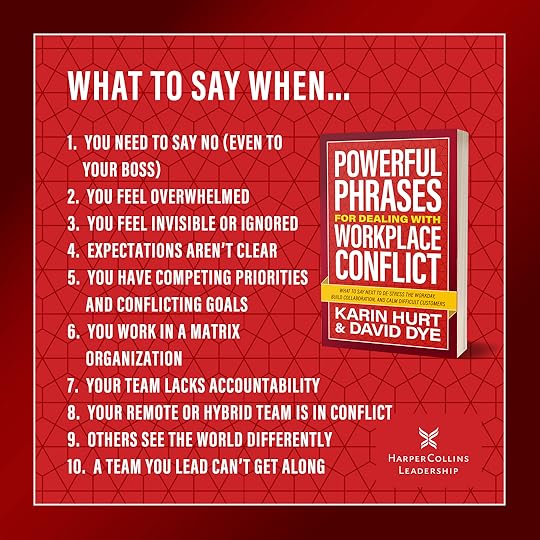
Click here for FREE Sample Chapters
The post How Do I Encourage My Coworker to Take Initiative? (without coming across as a jerk) appeared first on Let's Grow Leaders.
How Do I Encourage My Coworker to Take Initative? (without coming across as a jerk)
Hi Karin, “I’ve got a peer who will never take initiative. I’m always stuck feeling like I’m the one to push if we’re going to get anything done. I really don’t like that feeling. What should I do? How can I get them to step it up? #AskingForaFriend.”
This one’s tricky. After all, they are your peer. You’re NOT the boss of them. And, it’s impacting you, your work, and your results. Work is more stressful than it needs to be. Let’s fix that.
Today’s “Asking for a Friend” features Glain Roberts-McCabe, PCC, CTDP (she/her) with expert advice for showing up curious and getting clear on your request.
What Does It Mean to Take Initiative?“Take initiative” is one of those phrases like “be more strategic” or “don’t be so negative” which can be a lightening for workplace conflict.
That request is just too vague for most people. If you want someone to take initiative, a good place to start is to be clear about what success looks like.
Taking initiative might mean anticipating potential problems and proposing solutions, seeking out opportunities for innovation or improvement, or voluntarily taking on additional responsibilities to relieve pressure on your team.
Defining what it looks like to take initiative in a specific context requires setting clear expectations about proactive behaviors, the scope of autonomy, and the desired outcomes. This clarity helps transform the abstract notion of “take initiative” into actionable, observable actions, which enables the person to to contribute more effectively.
How to Start the Conversation

Understand that we all have different motivational energies. Some of us like to move fast. Some of us like a little slower, steady pace. And really it’s often that energy gap that’s causing all kinds of tension.
When you start there, it’s easier to give that co-worker the benefit of the doubt. It’s unlikely that the reason they aren’t taking initiative is to tick you off. They might be going slow to really think these through. Or they lack the confidence to speak up and share their ideas.
2. Invite ConversationSit down and ask your co-worker about how they like to work. Talk to them about what it feels like to have to work quickly. Ask what requests they have from you to make their work easier.
3. Make a RequestOf course, once they’ve shared their request, it’s easier to share yours. Here’s where you can tap into the very specific initiative-taking behaviors you are looking for. Don’t just say, “I need you to take initiative.” Instead, you might say something like, “I need you to proactively stakeholder your ideas with your boss before coming to me.” Or, I need you to do a quality check and fix any mistakes before you send the data for me to use.”
This Harvard Business Review Article, Mastering the Art of the Request, by Rae Ringle defines 5 questions to ground a better request.
What do you want?Who do you want it from? When do you want it by?What are the conditions of satisfaction?What’s the context?4. Schedule the FinishOnce you’ve both made your requests, don’t leave follow-through to chance. Schedule a time to talk about how things are going. This way, if your commitments to one another are working, you don’t need to remember to celebrate that success. And, if they don’t take the initiative you agreed to as promised, you don’t have to summon the courage to talk about the situation again, you already have it scheduled.
Your turn. What’s one of your favorite ways to help someone take initiative at work?

Click here for FREE Sample Chapters
The post How Do I Encourage My Coworker to Take Initative? (without coming across as a jerk) appeared first on Let's Grow Leaders.
How to Successfully Transform Your Team’s Conflict to Collaboration
Episode 251: In this episode, David Dye discusses transforming workplace conflict to collaboration. He introduces four dimensions that can help alleviate and deescalate conflicts. The four dimensions are: connection, clarity, curiosity, and commitment. David emphasizes the importance of having a conversation with oneself before engaging in conflict resolution and provides phrases and strategies for each dimension. David shares, “Powerful Phrases for Dealing with Workplace Conflict,” which offers over 300 phrases to deescalate conflicts and build trust. This episode will cover specific scenarios and provide practical tools for dealing with workplace conflict.
Practical Strategies for Navigating from Conflict to Collaboration00:00 – 00:56 – David kicks off season 16 with a focus on transforming workplace conflict to collaboration. David shares that 70% of surveyed individuals report experiencing the same or greater levels of conflict at work. This sets the stage for a deep dive into conflict resolution strategies.
00:57 – 02:02 – David introduces four key dimensions for addressing workplace conflict: connection, clarity, curiosity, and commitment. This framework aims to not only alleviate difficult conflicts but also promote better team collaboration.
02:03 – 02:37 – “Powerful Phrases for Dealing with Workplace Conflict” offers over 300 practical phrases to help deescalate common workplace disputes, emphasizing the importance of proactive communication in conflict resolution.
02:38-03:01 – Listeners like Nora, Jamie, Julianne, and others share their questions, highlighting the universal challenge of navigating workplace conflict to collaboration across various locations and contexts.
04:03 – 05:51 – David delves into the psychological aspects of conflict. He explains how the brain’s survival instincts can exacerbate workplace disputes. This underscores the importance of thoughtful response over instinctual reaction.
05:52 – 08:34 – There are many factors contributing to increased workplace conflict, including pandemic aftereffects, economic instability, and changing work environments. David shares a comprehensive overview of the challenges leaders face.
08:35 – 15:34 – Through a personal anecdote, David illustrates the transformative power of confronting conflict, showcasing how candid dialogue can lead to unexpected resolutions and personal growth.
15:35 – 19:16 – The conversation shifts to the first dimension of conflict resolution, connection. David explains the importance of knowing your colleagues as human beings. This illustrates how a deeper understanding of each other’s perspectives can significantly ease conflict resolution.
19:17 – 20:44 – Clarity is highlighted as the second crucial dimension for effective conflict management. David discusses how getting on the same page and creating a shared understanding of expectations and outcomes can prevent misunderstandings and foster a collaborative environment.
20:45 – 22:53 – Curiosity is introduced as the third dimension, emphasizing the role of genuine interest in others’ perspectives for uncovering the root causes of conflict. David suggests that asking insightful questions cannot only provide new solutions but also pull individuals out of reactive states, fostering a more empathetic and productive dialogue.
22:54 – 26:25 – The conversation culminates with commitment, the fourth dimension, where David outlines the importance of translating discussions into specific, actionable commitments. He stresses the necessity of clear actions, owners, and timelines to ensure progress and prevent recurring conflicts. This approach can transform conflicts into opportunities for growth and collaboration.
26:26 – The episode wraps up with a compelling call to action for you to engage with the four dimensions of conflict resolution in your day-to-day challenges. David encourages personal reflection on the impact of staying silent and advocates for proactive communication as a key to transforming workplace conflicts into collaborative successes.
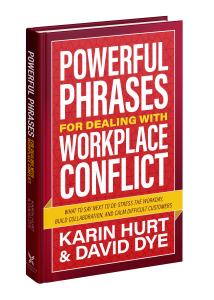 If you’d like more specific, practical phrases and approaches for common sources of workplace conflict, check out our newest book (May 2024—available for pre-order now): Powerful Phrases for Dealing with Workplace Conflict—What to say next to de-stress the workplace, build collaboration, and calm difficult customers.
If you’d like more specific, practical phrases and approaches for common sources of workplace conflict, check out our newest book (May 2024—available for pre-order now): Powerful Phrases for Dealing with Workplace Conflict—What to say next to de-stress the workplace, build collaboration, and calm difficult customers.
The post How to Successfully Transform Your Team’s Conflict to Collaboration appeared first on Let's Grow Leaders.
April 1, 2024
Employee Retention Strategies When Work Gets Chaotic and Messy
Transitions, reorganizations, layoffs, mergers, acquisitions—they are all part of the business landscape. And while effective leaders will work to limit the number and frequency of these events, they are inevitable as organizations work to stay relevant in a rapidly changing world. Effective employee retention strategies are critical to help your team come through the other side with confidence and enthusiasm for their work.
I Didn’t See This ComingWe were working with Melissa (not her real name), the Vice President of a rapidly growing national firm who called for help because three people had resigned in the past two weeks. And if you’d asked her two weeks before that, she wouldn’t have told you that any of them were flight risks.
As she explained the situation, Melissa’s department was in the middle of a major reorganization resulting from changes in the industry. The reorganization would shift an entire team’s work to an external partner (and several team members were moving over to the partner company.) Some roles would merge, and a few people would be reassigned or given exit packages.
Melissa told us, “I thought we were doing good with our communication, and that everyone understood what was happening. We’ve all been working so hard at our normal jobs plus preparing for the transition. Then these three resignations happened—and we can’t afford to lose anyone else. And they all have important work to do after the transition. I didn’t see this coming.”
Employee Retention Strategies During Reorganizations, Layoffs, and Corporate ChaosMelissa and her team started the change process well. They had a clear communication plan. The company had retention bonuses in place to help affected team members stay through the finish line, and they clearly defined the process, roles, and timelines. They’d also involved the team in early decision-making.
These are all good practices and we recommend them as you navigate chaotic changes.
And—there are some additional employee retention strategies you can use to help your team move through these changes with confidence.
Invest in Clarity with Cascading Checks for UnderstandingThe antidote to uncertainty is clarity.
And as much communication as Melissa had done with her team, there was still more to do. We asked Melissa a question that you can ask yourself: “If we were to go ask your department about the plan, the timelines, and their role in the changes, would they give us the same answer you would?”
Melissa said, “I’m pretty confident, yes.”
“Would you bet 1000 dollars on each person affected giving the same answer?”
She thought for a moment and said, “Yes, for my directors. I wouldn’t take that bet for their team members.”
This is a great gut-check to see if your communication is as effective as you hope it would be.
Here, Melissa realized there was an opportunity to work with her directors on more clear and consistent communication. Then, both she and her directors could follow up by talking with frontline team members to check for understanding. To hear the team member describe what was happening in their own words.
Communication doesn’t mean you said it (or sent it). Clear communication means everyone has received and internalized critical messages.
Re-Recruit Your A-PlayersThere’s no question that even with clear communication, hectic reorganization, downsizing, and other corporate chaos makes everyone nervous, particularly when cuts include strong contributors who happen to be in the wrong seat at the wrong time.
Re-recruit your top talent by connecting and communicating how much you value them. Help them see their future opportunities and how you’ll support their growth and development.
Get Their Hands In the FutureOne of the most powerful employee recruitment strategies when you face chaotic and messy change is to get people working on what’s next.
When you have team members who will stay on with the team after the change, get them working on that future. If their hands are deep into a project that builds the future, they can feel that future is real—and includes them. And that helps quell the uncertainty.
As we explored this strategy with Melissa, she recognized the opportunity: “I have many people who could absolutely be working on projects and plans that happen after the transition. We’ve been so focused on what’s happening now that I think I’ve made my team nearsighted.”
Maintain Relationships and Lines of CommunicationIn times of stressful change, it’s easy to lose track of your normal lines of communication.
In Melissa’s case, she noted that “Everyone’s been so busy. I thought we’d been transparent and clear, but we’re working so hard on our primary work, then to make the transition happen, that our one-on-ones and ongoing communication have taken a back seat.”
When one-on-ones feel the most difficult to maintain, that’s often when you need them the most. Those regular, individual check ins give you a chance to use all these employee retention strategies in a connected, relevant way.
Your Turn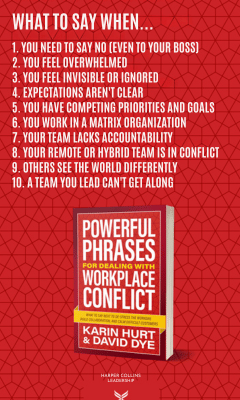 You have to expect some degree of corporate chaos as your company navigates a rapidly changing world. All the planning and thoughtful strategizing you or your leaders do can’t eliminate uncertainty.
You have to expect some degree of corporate chaos as your company navigates a rapidly changing world. All the planning and thoughtful strategizing you or your leaders do can’t eliminate uncertainty.
Help your team move through the change with confidence by investing in consistent communication to ensure clarity, thorough checks for understanding at every level, by getting everyone working on a horizon beyond the changes, and ensure you and your team maintain one-on-ones to stay connected.
We’d love to hear from you: what are some of your most effective employee retention strategies during times of significant chaos and change?
You might also like:
After the layoff: How to support your team when it just got smaller
The post Employee Retention Strategies When Work Gets Chaotic and Messy appeared first on Let's Grow Leaders.
March 29, 2024
Strategies to Lead Your Company Forward to the Future of Work
Episode 250: In this episode, you’ll hear David catching up with Dan Michelson, the author of “Holy Shift: Moving Your Company Forward to the Future of Work.” They tackle how critical trust is among leaders and the pivotal mindset shift needed to adeptly maneuver through the evolving work environment. Dan highlights the key elements like fostering community, opening doors for growth, cementing solid connections, and enriching employee experiences. He advocates for a transition from traditional management to a coaching approach, emphasizing personal growth and a culture of belonging. Dan shares actionable advice for leaders aiming to nurture community and connection in their teams.
Navigating the Future of Work: A Journey with Dan Michelson0:00-0:23: Dive into an enlightening chat with Dan Michelson, the genius behind “Holy Shift.” He shares a golden nugget right off the bat: trust isn’t just about receiving; it’s about giving it freely as a leader.
0:23-2:03: David celebrates a milestone episode and a deep dive into the seismic shifts in our work landscape. The conversation teases a future focus on resolving workplace conflicts.
2:03-4:03: Dan commends the podcast’s success and emphasizes optimism in leadership. He suggests that leaders now, more than ever, are pivotal in navigating through challenges with a forward-looking attitude.
Embracing Change: The Power of Trust and Optimism in Leadership4:03-5:36: Reflecting on his journey, Dan shares his unexpected path to leadership. It was shaped by personal challenges and a drive to make a difference.
5:36-7:19: Dan dives into the essence of leadership and underlines the power of making people and situations better. This will reshape our understanding of what it means to lead.
7:19-9:30: David and Dan discuss the often-overlooked aspects of leadership. A couple of examples are the role of insecurity as a driving force behind striving for excellence and the importance of self-evaluation.
9:30-11:56: Transitioning to Dan’s current endeavors, he introduces us to his innovative approach to fostering connections within organizations, especially in a remote work environment.
15:06-17:06: They explore a three-step methodology to embrace the future of work: recognizing the shift, changing mindsets, and putting plans into action to navigate through these changes effectively.
17:11-18:46: The discussion turns to setting ambitious goals for leaders, aiming to make your organization the best place employees have ever worked.
20:02-24:22: Addressing the CEO’s perspective, the conversation highlights the underlying reasons for wanting employees back in the office. They are focusing on long-term growth rather than short-term productivity.
25:32-29:12: AI’s impact on the workplace is also scrutinized. Dan emphasized the dual nature of AI as both a threat and an opportunity, depending on one’s adaptability and willingness to learn.
29:12-33:17: The shift from managing to coaching is discussed as crucial for modern leadership, emphasizing the importance of continuous, meaningful interaction with employees.
Connecting the Dots: Cultivating Community and Purpose in the Workplace33:58-37:30: They delve into the CORE framework, which focuses on Community, Opportunity, Relationships, and Experiences, as a foundation for addressing productivity, engagement, and retention.
37:30-44:59: Dan provides actionable advice for leaders to cultivate a sense of community and belonging within their teams. He urges you, as a leader, to personalize the company’s mission and values for your employees.
45:58-52:49: Wrapping up, Dan encourages leaders to facilitate conversations that allow employees to connect their personal experiences with the company’s goals, fostering a stronger sense of community and purpose.
This episode with Dan Michelson not only sheds light on the evolving nature of work but also provides practical insights for leaders to adapt and thrive in the future of work.
Thank you To Our GuestDan Michelson is the author of “Holy Shift: Moving Your Company Forward to the Future of Work” and CEO of InCommon which helps people grow their company and career by providing a dedicated, digital place to create relationships and build their professional network.
 If you’d like more specific, practical phrases and approaches for common sources of workplace conflict, check out our newest book (May 2024—available for pre-order now): Powerful Phrases for Dealing with Workplace Conflict—What to say next to de-stress the workplace, build collaboration, and calm difficult customers.
If you’d like more specific, practical phrases and approaches for common sources of workplace conflict, check out our newest book (May 2024—available for pre-order now): Powerful Phrases for Dealing with Workplace Conflict—What to say next to de-stress the workplace, build collaboration, and calm difficult customers.
The post Strategies to Lead Your Company Forward to the Future of Work appeared first on Let's Grow Leaders.
March 25, 2024
How to Navigate Unclear Expectations and Fuzzy Norms at Work
Often, people have unspoken values or expectations, and there isn’t one “right” way to do things. Maybe your manager never clarified an important process. Or the team hasn’t agreed on norms, so you’ve found yourself in a conflict cocktail of vague and unclear expectations and strong points of view.
Here’s an example that many remote and hybrid teams experience: should you have your cameras on during a meeting?
Your coworker, Rachel, may feel like it’s completely unnecessary. It drains her energy. Most of the time, no one asks her opinion anyway, and her surroundings aren’t chic, so why turn on the camera? For her, a camera-off policy is as comfortable as wearing pajamas during a work call – no one knows, but it feels just right.
For Zach, however, the lack of face time is disrespectful and frustrating as he presents his project and seeks feedback. “Cameras should always be on,” he insists, “unless you’ve got to step away or sneeze or something.” He views a camera-on policy like a firm handshake – a sign of respect and engagement.
“No,” interjects your colleague, Pat, “that’s wasteful and unnecessary. We only need to be on camera for clients or for a real discussion.” Pat prefers a pragmatic approach, seeing camera use as a tool, not a rule, like using an umbrella only when it rains.
This is a classic case of unclear expectations creating ‘camera drama,’ where a lack of established norms creates conflict. None of these people is “right” as there is no objectively “right or wrong” answer for cameras. It’s more about preference than policy, like choosing between coffee or tea for your morning boost.
Finding Clarity When Rules Are FuzzyIn every organization, there will be activity that isn’t covered by a corporate policy. As norms shift, technology changes, and social standards develop, you and your team can resolve these ambiguous norms and unclear expectations with a conversation. If there’s no company policy, it can either become a conflict—or an opportunity to use some Powerful Phrases and build a team agreement, much like deciding on the office’s unofficial dress code.
This is one of those workplace conflicts that takes some investigation and intentional conversation to understand what’s happening. It’s so easy to get caught up in an argument without realizing that it’s really a lack of clarity, like arguing over who finished the milk without checking the fridge first. As you see a conflict building, start with Powerful Phrases that “put the fish on the table,” and help people understand what’s happening.
Note: This article contains 12 vital “clarity habits” for better collaboration.
Powerful Phrases for Dealing with Unclear Norms and Expectations“It seems that we see this differently…”“It is very simple, but hard to do. Set expectations and follow through.”
-Male, 65, Israel, The World Workplace Conflict and Collaboration Survey
Summarize the situation and call attention to the fact that people have different perspectives. This might feel like stating the obvious, but it helps everyone rise above their position to see the situation more objectively, like taking a step back to see the whole elephant, not just its trunk.
“Here’s the challenge we face…”Now you describe the consequences if the lack of clarity continues. For example: “There’s no rule about this, so it’s up to us to figure out. The challenge we face if we don’t agree on how we use cameras is that we’ll all feel resentful, disrespected, and exhausted.”
“I know that’s not what we want… I’m confident we can…”As you describe the negative consequences, you can then call everyone to their best intentions with this Powerful Phrase. It assumes good intent. For example:
“I know we don’t want to exhaust each other. And I know we all want to feel supported, seen, respected, and valued as we do our work. I’m confident we can come up with an agreement that will work for all of us.”
“Let’s decide how to decide.”At this point in your conversation, the team might realize that it’s someone’s job to make a call. If so, invite them to the discussion or make an appointment to talk with them. Use the same Powerful Phrases from Chapter 12—Navigating Competing Goals to have a conversation with the decision-maker and get clarity.
But, when there’s no assigned decision-maker, it’s helpful to agree first on how the group will decide. Usually, this is going to be a vote or consensus. In a vote, the majority rules. In consensus, everyone can live with a choice, even if it wasn’t their first option. For example:
“Okay, this one’s our call. Is everyone comfortable with a vote? Or do we want to go for consensus?”(And yes, that’s an example of a quick consensus decision about whether to use a vote or consensus. So meta, right?)
In conclusion, navigating the murky waters of workplace norms and unclear expectations can be like trying to assemble furniture without instructions – frustrating, but not impossible. By using Powerful Phrases, teams can not only build bridges over these gaps of misunderstanding but also strengthen their collaborative spirit. Remember, the goal isn’t to win the argument but to find a solution that works for everyone, like choosing a movie everyone can enjoy on movie night. So next time you’re in a camera-on or camera-off debate, remember, it’s not just about seeing faces; it’s about seeing eye to eye.
Your turn. What’s one powerful phrase you like to use to clarify unclear expectations?
Interested in more Powerful Phrases for Dealing With Workplace Conflict? Click on the image below to download FREE sample chapters.

Click here for FREE Sample Chapters
The post How to Navigate Unclear Expectations and Fuzzy Norms at Work appeared first on Let's Grow Leaders.
March 22, 2024
Discover the Power of Meaningful Work in the Era of AI
In this episode, you’ll join David Dye as he hosts Ed Hess, author of “Own Your Work Journey,” in a deep dive into discovering the power of meaningful work in the era of Ai. Ed explores the crucial role of critical thinking, emotional intelligence, and trade jobs in the era of smart technology. Ed gives you the tools to take ownership of your thinking, listening, and collaboration skills so you can thrive even during fast technological change.
Ed emphasizes the value of humility and encourages you to actively seek out conflicting information to challenge your beliefs. He recommends finding an accountability partner and engaging in deliberate practice to continuously improve and adapt to the changing landscape.
As the episode wraps up, Ed will inspire you to embrace smart principles and take control of your ego, emotions, and behaviors to truly stand out in the workplace. So, if you’re looking to navigate the modern professional world while maintaining your integrity, tune in to this insightful discussion.
Unlocking Meaningful Work: Navigating Smart Technology and Human Value00:00 – 03:10: The Future of Work in the Age of Smart Technology
Technology’s rapid advancement means it will soon outpace human intelligence. Critical thinking is essential amidst societal divisiveness, emphasizing the need for innovative problem-solving.
03:10 – 07:18: Introduction to Ed Hess and Meaningful Work
Ed stresses the importance of meaningful work amidst technological change. Success lies in adapting skills that differentiate humans from technology: critical thinking, emotional connection, and specialized trade jobs.
07:18 – 10:24: Three Ways to Add Value Beyond Technology
Ed outlines three essential skills to maintain relevance: critical thinking, emotional connection, and specialized trade jobs. These skills are crucial for you to thrive in an increasingly automated world.
10:24 – 14:50: Cultivating Critical Thinking and Emotional Connection
Critical thinking and emotional intelligence are pivotal for fostering positive relationships within your business. Human-centric leadership involves building caring, trusting relationships, essential for long-term success.
14:50 – 18:59: Overcoming Internal Challenges for Personal Growth
The biggest obstacle to personal growth is often internal, rooted in human nature’s resistance to change. Rewiring ourselves to embrace curiosity, openness, and self-reflection is key to unlocking our full potential in the workplace.
21:53 – 25:51: Cultivating Meaningful Work and Happiness
The long-term commitment required for personal transformation, achieving meaningful work and happiness is not a quick process but rather a lifelong journey. The importance of humility in the context of the “new Smart” principles introduced by Ed, highlight how humility is essential for adapting to smart technology and radical change.
30:17 – 37:56: The Power of Deliberate Practice and Accountability
The significance of deliberate practice in personal development, David draws examples from various fields to illustrate its importance in skill acquisition and mastery. He also reflects on the positive impact of accountability partnerships in personal growth, sharing anecdotes of individuals who found it to be the best thing they’ve ever done for their professional and personal development.
39:38 – 43:35: Navigating Workplace Dynamics with Humility
Ed addresses concerns about showing humility in a competitive workplace environment. He advises approaching interactions with colleagues tactfully, suggesting that asking questions rather than imposing beliefs can foster productive dialogue. He emphasizes the importance of understanding others’ perspectives while maintaining personal integrity and resilience.
48:29 – 51:08: Making Personal Development Accessible
David discusses accessibility to personal development resources, highlighting the affordability of Ed’s book and online content. He encourages you invest in your growth, emphasizing the transformative potential of applying principles such as critical thinking and self-reflection. He underscores the value of ongoing learning and adaptation in navigating the challenges of the modern workplace.
50:42 – end: Embracing Challenges as Part of the Journey
Inevitability you will face challenges and setbacks on the path to meaningful work and happiness. Perseverance and self-awareness are important. Overcoming obstacles is an integral part of the journey towards personal and professional fulfillment.
Thank you To Our GuestEd Hess has 20 years experience as business executive before joining academia. Author of 15 books, over 160 articles for practitioners and 60 Darden Cases. Ed’s work has appeared in over 450 media outlets globally. For a copy of his book, check out his website, ownyourworkjourney.com.
 If you’d like more specific, practical phrases and approaches for common sources of workplace conflict, check out our newest book (May 2024—available for pre-order now): Powerful Phrases for Dealing with Workplace Conflict—What to say next to de-stress the workplace, build collaboration, and calm difficult customers.
If you’d like more specific, practical phrases and approaches for common sources of workplace conflict, check out our newest book (May 2024—available for pre-order now): Powerful Phrases for Dealing with Workplace Conflict—What to say next to de-stress the workplace, build collaboration, and calm difficult customers.
The post Discover the Power of Meaningful Work in the Era of AI appeared first on Let's Grow Leaders.
How to Craft a More Meaningful Apology at Work
“Hey Karin, I’ve got a good team. We’re full of good intentions. We really do care about each other. But I’ve been noticing… we’re moving so fast, and sometimes we step on one another’s toes. Sometimes we offend. Sometimes we really screw things up. We seem to be missing the art of a meaningful apology. How can I help my team get better at that? #askingforafriend.
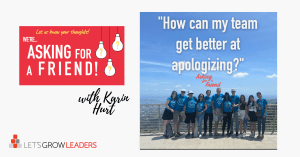
What makes for a meaningful apology?
How do you make apologizing when you screw up a habit on your team? Today I share some insights from my fellow Together We Can Change The World speakers at the
1. Mean it.Be sure you really mean it (be sincere). Don’t make all kinds of excuses, but come from the heart. Scott Friedman, Global Speaking Fellow, CSP
2. Change your behavior right after.The words don’t help change the behavior. Change your attitude and actions. Raju Mandhyan
3. Don’t mess up to begin with.Be thoughtful about what you do, so you don’t have a reason to say I’m sorry and apologize. So, think first, before you do. Lori 🙌🏾🇯🇲🇺🇸 Pace
4. Give them an opulent gift like a marble statue (or any opulent show of wealth) 😉You need the venue context for this one, LOL. Sebastian Hurt
You see, the Temple of Leah is considered the “Taj Mahal of Cebu.” It’s a shrine built by Teodorico Soriano Adarna in honor of his late wife, Leah Villa Albino-Adarna. Complete with enthralling Doric columns and arches, it is a sanctuary symbolizing a husband’s undying love for his wife. And apparently, it’s an apology for his philandering.
5. Make it unconditional without any expectations.When you give without expectations, you are sending out positive vibrations. Harold Payne
6. ________________ (your turn).
What would you add? What are the elements of a meaningful apology?
See Also:Beyond the Drama: How to De-Escalate an Emotional Conversation at Work
The post How to Craft a More Meaningful Apology at Work appeared first on Let's Grow Leaders.
March 18, 2024
From Misunderstanding to Mastery: Four Dimensions to Transform Your Cross Cultural Leadership
Cross cultural leadership is a fantastic chance to broaden your impact and develop teams that excel in performance and innovative problem-solving. You can achieve these outcomes when you recognize the challenges and focus on four dimensions of team collaboration.
That Wasn’t a ComplimentEarly in my (David’s) career, I worked in a very culturally diverse organization. A few months into my work there, a man named Jack took me aside and said, “David, I noticed that when you come into our all-hands meeting, you walk straight up to the front row, sit down, open your notebook and are ready to take notes.”
Happy that he’d seen my focus and preparation, I answered, “Jack, thanks for noticing.”
He put his hand on my shoulder and said, “Brother, that wasn’t a compliment.”
Jack explained that when I entered the room and sat down, focused on the meeting and the work, I was not greeting my colleagues and engaging in pre-meeting conversations. “To us,” he explained, “that comes across as either you don’t like us or you think you’re better than us. And I don’t think that either of those is true—I just don’t think you know any better, so I wanted to tell you.”
It was an early lesson in cross cultural leadership, and I am so grateful for Jack having that conversation with me.
Cross Cultural Leadership ChallengesRecently, we were working in the Philippines when a leader asked me (Karin) how to help their team speak up with ideas or identify problems and potential solutions. The heart of their question was a cross cultural leadership challenge. Their team is from a culture that prioritizes respect for elders and authority figures and minimizes direct confrontation or criticism.
We’ve had many leaders, managers and clients around the world approach us with different cross cultural leadership challenges including:
“In my culture, we need sound and music to do our best, but my office is silent as a graveyard. It’s so depressing and hard to feel energy for anything.”“I don’t “care” or want to be friends with my team. Culturally, this does not work for me.” (This leader WAS invested in her team’s success—the words “care” and “friend” meant something different for her than they do for others.)“In my culture, when someone offers you a favor or food, you decline. They offer again, you decline. They offer again, and then it is polite to accept. But in this country, I must be rude and say ‘yes’ the first time or they stop asking.”“When I ask the team for status updates, they tell me everything is good, even when I know it can’t possibly be going well.”These are just a few examples of the many cross cultural leadership challenges you might face.
The Price of Cross Cultural ConflictThere are so many benefits to leading a cross cultural team (better problem solving and performance are just two examples), but failing to lead intentionally can also cause serious problems including:
1. Erosion of Trust and RespectIgnoring cross-cultural challenges can lead to a significant erosion of trust within a team, as team members may feel the team undervalues or misunderstand their backgrounds and perspectives. This erosion of trust undermines team cohesion and can significantly affect morale and productivity.
2. Reduced Innovation and CreativityA failure to address cross-cultural leadership challenges stifles the creative potential of a team. When team members from various cultural backgrounds don’t feel included or understood, they are less likely to contribute their unique insights and ideas, leading to a homogenization of thought that can stifle innovation and limit problem-solving capabilities.
3. Increased Conflict and MiscommunicationCross-cultural challenges often manifest in misunderstandings and misinterpretations, which can escalate into conflicts and ultimately lead to a toxic work environment.
4. Reduced Global CompetitivenessFailing to address cross-cultural challenges compromises your ability to operate effectively across different markets. You can struggle to attracting talent, collaborate with partners, and serve your customers.
Four Dimensions of Cross Cultural LeadershipThere are four dimensions of team collaboration that will help you lead cr
oss culturally and bring out the best from your team.
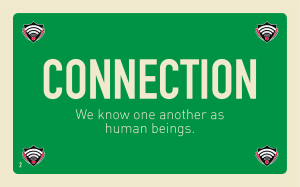
Leadership is a relationship, and that’s never truer than when you lead a team of people from different cultures—especially when their culture is different from your own.
Building that relational knowledge for yourself and everyone on your team will help prevent misunderstandings and give you a platform to bring out the best in your team.
There are many ways to build cross cultural connection, but you don’t want to leave it to chance. People will certainly learn about one another slowly over time, but why wait?
Facilitate sharing and model with your listening and learning. The time you invest up front to help a cross-cultural team connect and understand one another will pay huge returns in saved time and innovation. Here are a few activities you can incorporate into your meetings to help build connection (these should be shared activities where everyone can participate, with you leading by example—avoid pressuring one person to educate a group about their culture):
How do you… – Invite your team to pick a different subject from time to time – for example: How do you offer to do someone a favor or food? Politely say “no”? Celebrate birthdays?Colorful metaphors – Invite team members to think of a fun or colorful metaphor, cliché, proverb, or saying that they grew up with and then explain its meaning. (A favorite of ours we learned from our Swiss clients is “Put the fish on the table.” It means “have the conversation about the uncomfortable subject.”)Myth-busting – Invite team members to share one myth or stereotype that they believe people sometimes think about their culture. Then they ‘bust the myth’ by clarifying the reality as they know it.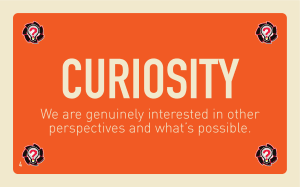 2. Curiosity
2. CuriosityAfter connection, curiosity is a vital dimension of cross cultural leadership. An attitude of learning, flexibility, and ability to look at issues from different perspectives will help you bring your team together. This means approaching your leadership and coaching with questions and seeking genuine understanding.
One of the most important aspects of leading with curiosity is to avoid judging and instead ask, “How can we?”
For example, you might be tempted to judge a team that prizes respect for authority and think, “They won’t ever tell me the truth and I can’t count on them.” That attitude limits your creativity and automatically puts you in opposition to your team.
Instead, asking a “How can we?” question will help you reframe the challenges your team faces.
One practical application is to ask, “How can we reframe this issue in terms that support, rather than erode, cultural norms?” For example, if you have a team member who prizes peaceful coexistence or deference to authority and doesn’t speak up with problems they observe, you can reframe the issue as one of peace or respect for authority. For example:
“In our team, the best way to create peace or to show respect for your teammates or leader is to bring up issues which can cause us harm.”
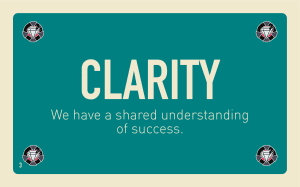
As you build connections and learn one another’s styles and cultural preferences, the next dimension to help you lead a cross cultural team is clarity.
Specifically, you want to invest in clarity about the culture of this team or organization. This is an open discussion about the norms and ways in which the team will operate. The goal is to define (and continually redefine) a shared culture.
This starts with your mission and values. What are you here to do? How will commit to doing that work with one another? Two of the most important clarity conversations you can have about values are:
“What does this look like in practice?”“What do we do when these values conflict with one another?”Ask these two questions regularly. Share your own stories. Occasionally, invite other leaders or executives to share their stories and examples. If culture is “what people like us do,” then story-telling is the engine that drives your team’s culture.
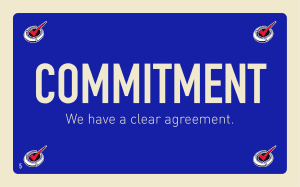
The final dimension of your cross cultural leadership is to make it all happen. Commitment is the alchemy that transforms the Connection, Curiosity, and Clarity into performance. There are three aspects of commitment that will carry your team to new heights.
PracticeIt takes time to build a new culture, to incorporate our understanding and new relationships, and to learn how to reframe cultural values for team performance. You will have missteps and misunderstandings. Use these as opportunities to circle back to connection and curiosity and build new clarity. Practice your team norms and values when the stakes are low.
CelebrateAs you build a new culture together, watch for moments of commitment. When someone recognizes their teammate’s values, celebrate. When a normally silent teammate raises their hand, encourage them. Build in time to “look down the mountain” and see how far you’ve come as a team – what understanding to you take for granted now that was very different ten months ago?
Use Yourself for AccountabilityOften, one of the more challenging aspects of cross cultural leadership is building a culture of accountability. And one of the most effective ways to create the psychological safety and model what success looks like is to use yourself as the subject of accountability.
For example, when you don’t follow through on your word (even if it’s for a justifiable reason), and someone mentions it, stop everything and celebrate. That’s a huge moment and exactly what needs to happen! And if no one says anything, ask your team if they noticed your dropped ball, and use it as a moment to invite their accountability. You can even use the moment to practice using the specific words. For example, “I noticed that we don’t have what you mentioned.”
When you help people practice accountability ON you and celebrate when they do, you make it safe for everyone to learn, grow, and practice accountability with each other.
Your TurnCross cultural leadership is a wonderful opportunity to expand your influence and build higher performing teams who solve problems creatively. You’ll get these results when you invest in Connection, Curiosity, Clarity, and Commitment.
And, we’d love to hear from you—what’s one of your most effective approaches for leading diverse teams and helping everyone succeed together?
The post From Misunderstanding to Mastery: Four Dimensions to Transform Your Cross Cultural Leadership appeared first on Let's Grow Leaders.
March 15, 2024
Culture, Fit, and Employee Motivation Strategies
In this podcast episode, Andre Martin discusses the importance of finding the right fit in your career and building a culture that supports employee motivation, engagement, and satisfaction. He emphasizes the need to reflect on values, goals, and ideal work environment before making career decisions. Martin also suggests that as leaders, we should focus on re-recruiting our existing employees by answering four key questions: (1) why the world is better with our company in it, (2) how our company makes money and has an impact, (3) how work gets done at its best, and (4) what the company’s promise to its employees is. By addressing these questions and creating a culture that aligns with employees’ values and goals, organizations can improve employee motivation and productivity.
Unlocking Employee Motivation: The Secret to a Thriving Workplace(00:00) The Journey Begins: Start your journey with a profound realization from Andre Martin: every decision nudges you towards or away from your ideal career. Reflect on what drives you—company, craft, or cause—to navigate your path wisely.
(00:29) Leadership & Future Insights: David introduces the essence of “Leadership without Losing Your Soul,” promising future explorations into workplace harmony. Get ready for a deep dive into creating environments where employee motivation thrives, and conflict dissipates.
(01:32) Meet the Expert, Andre Martin: Andre, with his rich background in organizational psychology and talent management, shares his mission to align careers with personal values, igniting a discussion on finding satisfaction and purpose in work.
(02:41) Leadership at Its Core: Andre recounts early leadership lessons learned from family responsibilities, emphasizing empathy and support as foundational pillars of effective leadership.
(04:22) Cultivating a Thriving Workplace: Discover the secret to transforming stress into positive energy and the quest for the right fit in the workplace, emphasizing the importance of a culture that aligns with personal working styles for productivity, satisfaction, and employee motivation.
(07:26) Deep Reflection Before Action: Andre stresses the importance of deep self-reflection before making career moves. Understand your core values and long-term vision to navigate the job market effectively and avoid the allure of superficial attractions.
Revolutionize Your Career Path: Finding Purpose and Passion in Every Step(11:49) Crafting Your Career: Learn about the three career types—company, craft, and cause—and how identifying your primary motivation can guide your career decisions, ensuring a more fulfilling professional journey.
(16:59) Navigating the Job Search: Andre offers insights into the job search process, emphasizing the importance of understanding a company’s work culture and the specific role you’re applying for to ensure a right fit.
(22:50) The Interview Strategy: Uncover strategies to dig deeper during interviews, asking questions that reveal the true nature of the workplace and ensure alignment with your career aspirations and working style.
(29:37) Building a Positive Relationship with Time: Andre concludes with advice on maintaining work-life balance, avoiding the trap of overworking, and ensuring that success and high performance come within a healthy timeframe, emphasizing the necessity of recovery and personal growth.
Thank You to Our GuestAndre Martin, a growth-oriented talent management executive with 20+ years of experience in talent development, executive team development, , strategy development, employee engagement, organization development, culture change, c-suite assessment & succession planning, innovation/design thinking, and employee experience design. And, a father, a husband, and a wildly curious learner who is dedicated to ensuring iconic brands become iconic companies.
 If you’d like more specific, practical phrases and approaches for common sources of workplace conflict, check out our newest book (May 2024—available for pre-order now): Powerful Phrases for Dealing with Workplace Conflict—What to say next to de-stress the workplace, build collaboration, and calm difficult customers.
If you’d like more specific, practical phrases and approaches for common sources of workplace conflict, check out our newest book (May 2024—available for pre-order now): Powerful Phrases for Dealing with Workplace Conflict—What to say next to de-stress the workplace, build collaboration, and calm difficult customers.
The post Culture, Fit, and Employee Motivation Strategies appeared first on Let's Grow Leaders.

